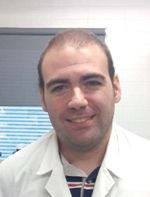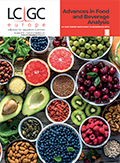Categorizing Olive Oil Using Untargeted GC–MS with a Multivariate Statistical Approach
Special Issues
Carlos Sales and Joaquin Beltrán from The Research Institute for Pesticides and Water at the University Jaume I, in Castellón, Spain, discuss a novel untargeted gas chromatography–mass spectrometry (GC–MS) method, incorporating dynamic headspace (DHS) with thermal desorption and a novel deconvolution approach, to classify olive oil.
Carlos Sales and Joaquin Beltrán from The Research Institute for Pesticides and Water at the University Jaume I, in Castellón, Spain, discuss a novel untargeted gas chromatography–mass spectrometry (GC–MS) method, incorporating dynamic headspace (DHS) with thermal desorption and a novel deconvolution approach, to classify olive oil.
Q. Your group recently published a study on the development of an untargeted gas chromatography–mass spectrometry (GC–MS) method and statistical approach to classify olive oil quality (1). What led your group to investigate this approach?
Carlos Sales and Joaquin Beltrán: In 2012 our group started a collaboration with the Interprofesional del Aceite de Oliva Español looking for a method for virgin olive oil quality classification complementary to the official classification method, known as a panel test. A panel test is a human-based approach composed of a team of specialists that give a numerical value to many characteristics about flavours, synthesizing a sensory analysis. The oils are classified according to two main properties: defects (negative factors) and positive attributes (positive factors). The major sensory defects are rancid, fusty/muddy sediment,musty/humid/earthy, acetone, burnt/heated, frozen/wet wood, and winey/vinegary, and the positive attributes can be fruity (specifying green attribute), bitter, and spicy. From the beginning, we decided to develop a method based on the volatile fraction of the oil because the volatiles present in olive oil are considered to be predominantly responsible for flavour, and therefore directly related to oil classification as extra virgin or virgin. Using this perspective and taking into account the high number of volatile compounds present in olive oil (2), which can vary depending on the geographical region of the olive cultivars, the type of olives, and climatic factors, we focused on the development of a nontargeted method based on the capabilities that a novel GC–atmosphericâpressure chemical ionization (APCI) in GC–MS offers for the detection of the molecular ion for every analyte (3). Data produced with this analytical approach were treated with automatic open source MzMine 2.0 deconvolution software (http://mzmine.github.io/) to extract the relevant chemical information and then treated with multivariate statistics to define which volatiles were responsible for each olive oil class (extra, virgin, and lampante) or defect (including “rancid”, “fusty”, “musty’, “acetone”, “burnt”, “frozen”, and “winey”).
Though the results obtained were quite promising for the quality classification of olive oils, the method had three main drawbacks. First, the equipment used, GC–APCIâquadrupole timeâofâflight (QTOF)-high resolution mass spectrometry (HRMS), is complex and not available in many routine laboratories that would find this approach useful for olive oil quality control. Second, the extraction used, based on an in-house purge-andâtrap method (4) with solvent elution, is time-consuming and requires solvent evaporation prior to injection, which can discriminate some of the most volatile components. Finally, GC–APCI–HRMS lacks spectral libraries to compare the experimental spectra, which makes elucidation a complex and time-consuming step when analyzing unknown compounds. With that in mind, efforts were devoted to the development of a GC–EI-MS metabolomic approach method with a single quadrupole as analyzer, making use of dynamic headspace entrainment followed by thermal desorption to achieve the same purpose with an easier sample treatment and using a more affordable and less complex instrument (1).
Q. What are the benefits of this method over other existing methods for olive oil classification?
CS and JB: When classifying olive oils, most analytical methods rely on target analyses to distinguish between olive oils with different attributes (5). These methods focus on a determined number of predominant compounds, but miss all the chemical information not predefined (targeted) in the acquisition method. With recent advances in data treatment, nontargeted analysis has been used for the classification of olive oil, mainly by variety or by cultivar region (6). For olive oil quality classification, the preferred methods are based on headspace as the sampling technique and GC–MS or GC–FID focusing on selected compounds. The technique developed in our group relies on dynamic headspace (DHS) with thermal desorption, which allows preconcentration of the sample prior to the injection without discrimination of the low boiling point compounds.
Additionally, the use of the novel open source deconvolution software for GC–MS analysis, PARADISe (http://www.models.life.ku.dk/paradise) (based on the PARAFAC2 algorithm) offers enhanced classification results in terms of sensitivity and accuracy to be obtained. This deconvolution software uses the full spectra enclosed within a defined retention time interval, and is able to distinguish between coeluting compounds or markers. The tentative markers obtained with PARADISe are compounds instead of combinations of mass-to-charge ratio (m/z) ions and retention time, which reduces the data matrix and produces more robust results, as interfering ions are not picked as a potential marker. This leads to an enhanced olive oil classification together with a quick identification of most relevant markers.
Q. Can this method be used to classify any other food products?
CS and JB: We believe this method could be effectively applied to any food product where several volatile compounds could be responsible for class characteristics. Indeed, the method comes from the group expertise analyzing tomato and melon volatiles, in which traditional methods were already successful to determine the volatile organic compound (VOC) fingerprint of the different samples (7,8). This method only requires a liquid or solid matrix in which volatile compounds can define the characteristics of a class by themselves, so it could theoretically be applied to almost any vegetable and fruit matrix. It can be extended to other food products and compounds using different analytical approaches (changing both extraction and determination technologies) and thus is not always limited to volatile fraction of the samples.
Q. What were the main analytical challenges you encountered and how did you overcome them?
CS and JB: When applying dynamic headspace entrainment, all the parameters regarding volatile extraction and desorption into the system must be carefully selected. To pick the most suitable sorbent trap, extraction, and desorption conditions, we used a design of experiment (DOE) method based on response surfaces to optimize all these parameters in two days instead of evaluating the results changing one variable at a time. As no automated DHS sampler was available in our laboratory, we adapted an in-house device previously used for the analysis of volatiles in tomato and melon (4,9) to be able to work with thermal desorption traps. This allowed us to cut extraction times, as up to six different samples can be extracted at the same time. However, in routine laboratories this could be escalated (or even automated) as needed, with the chromatographic run-time the only limitation in terms of number of samples analyzed each day.
Q. Are there any problems associated with developing nontargeted methods generally for GC?
CS and JB: When developing nontargeted methods, especially using automated deconvolution software, some considerations have to be made. First, the method must cover the largest number of compounds possible, as no information about the key compounds is known from the beginning. In our case, we decided to focus on the volatile fraction, but many scientists apply different techniques (both GC–MS and liquid chromatography [LC]–MS) to avoid discriminating against any compound. The same applies to the chromatographic run. A good compromise between chromatographic resolution and analysis time is crucial to obtain a robust method applicable when analyzing a large number of samples. Here, the use of PARADISe also helped because its peak resolution power allows up to eight coeluting peaks (10) to be discriminated. Identification of the markers is still the weakest part of the nontargeted methods and is what slows down transfer of the methods to routine laboratories.
Q. Do you have any comments on the multivariate statistical-based approach you used? Are there any novel aspects or benefits to the approach you used here?
CS and JB: Partial least squares-discriminant analysis (PLS-DA) has been extensively used for classification purposes. Though it is easy to apply and there are a lot of free software options capable of performing PLS-DA, it must be carefully applied to avoid model overfitting. In this case, the novelty is the use of PARADISe as deconvolution software because it compares full spectra within specified retention time windows, giving around a hundred variables (compounds) to work with. Other free deconvolution software, such as the XCMS package of R and MzMine2, can lead to an output matrix ranging from hundreds to thousands of variables because they detect combinations of single ions at a retention time. Such big data matrices then need extensive data treatment to avoid “ghost”and interfering ions. Additionally, a high number of variables tend to model overfitting when applying PLSâDA, which can result in a perfect classification of the samples used to create the model, but a bad classification of blind samples. It must also be noted that PLS-DA, when applied to more than two groups, can lead to misclassification of samples that actually do not belong to any of the modelled classes. In this work, with all the samples provided by official control laboratories and all being certified olive oil samples, there is no chance to misclassify an olive oil as not an olive oil. For other classifications, PLS-DA might not be the best choice, and one class models should be applied to get more reliable results.
Q. Are there any other applications where you think this method could offer the analyst improved results?
CS and JB: In the field of food studies, we have been developing new methods based on the strategy described here that have been successfully applied to the study of the classification of smoked fish depending of the smoking treatment and intensity. In this case, we again used the volatile fraction of the sample as a chemical print related to the taste and conservation of the fish.
Q. What is your group working on next?
CS and JB: We have started to treat metabolomic in vivo studies using laboratory organisms to reveal chemical compounds related to the behaviour of animals. These studies have only just started and include not only volatile analytes but also nonvolatile compounds that require the combined use of GC and LC coupled to MS.
Acknowledgement
The Research Institute for Pesticides and Water [IUPA] is directed by Félix Hernández and is where this research has been conducted. Joaquin Beltrán and Tania Portolés have been directing this research as supervisors of Carlos Sales dissertation, and are conducting the ongoing research.
References
- C. Sales, T. Portolés, L.G. Johnsen, M. Danielsen, and J. Beltran, Food Chem.271, 488–496 (2019). doi:10.1016/j.foodchem.2018.07.200.
- F. Angerosa, M. Servili, R. Selvaggini, A. Taticchi, S. Esposto, and G. Montedoro, J. Chromatogr. A 1054, 17–31 (2004). doi:10.1016/j.chroma.2004.07.093.
- C. Sales, M.I. Cervera, R. Gil, T. Portolés, E. Pitarch, and J. Beltran, Food Chem.216, 365–373 (2017). doi:10.1016/j.foodchem.2016.08.033.
- J. Beltran, E. Serrano, F.J. López, A. Peruga, M. Valcarcel, and S. Rosello, Anal. Bioanal. Chem.385, 1255–1264 (2006). doi:10.1007/s00216-006-0410-9
- M.T. Morales, G. Luna, and R. Aparicio, Food Chem.91, 293–301 (2005). doi:10.1016/j.foodchem.2004.06.011.
- N.P. Kalogiouri, R. Aalizadeh, and N.S. Thomaidis, Food Chem. 256, 53–61 (2018). doi:10.1016/j.foodchem.2018.02.101.
- A. Fredes, C. Sales, M. Barreda, M. Valcárcel, S. Roselló, and J. Beltrán, Food Chemistry190, 689–700 (2016). doi:10.1016/j.foodchem.2015.06.011.
- J. Beltran, E. Serrano, F.J. López, et al., Anal. Bioanal. Chem.385, 1255 (2006). doi:10.1007/s00216-006-0410-9
- A. Fredes, C. Sales, M. Barreda, M. Valcárcel, S. Roselló, and J. Beltrán, Food Chem.190, 689–700 (2016). doi:10.1016/j.foodchem.2015.06.011.
- L.G. Johnsen, P.B. Skou, B. Khakimov, and R. Bro, J. Chromatogr. A1503, 57–64 (2017). doi:10.1016/j.chroma.2017.04.052.

Carlos Sales is a Ph.D. student in sciences at the Research Institute of Pesticides and Water in the University Jaume I, in Castellón, Spain. His research is focused on two main topics: GC–MS combined with a novel APCI source for the quantification of persistent organic pollutants and volatile organic compounds in complex environmental and food samples, and also the development of untargeted GC–MS and GC–HRMS techniques for the quality classification of food products.

Joaquin Beltrán is Full Professor in the Physical and Analytical Chemistry department and member of the Research Institute of Pesticides and Water of the University Jaume I. His research focuses on the use of GC–MS techniques in the lastest generation high-resolution MS instruments.

Analytical Challenges in Measuring Migration from Food Contact Materials
November 2nd 2015Food contact materials contain low molecular weight additives and processing aids which can migrate into foods leading to trace levels of contamination. Food safety is ensured through regulations, comprising compositional controls and migration limits, which present a significant analytical challenge to the food industry to ensure compliance and demonstrate due diligence. Of the various analytical approaches, LC-MS/MS has proved to be an essential tool in monitoring migration of target compounds into foods, and more sophisticated approaches such as LC-high resolution MS (Orbitrap) are being increasingly used for untargeted analysis to monitor non-intentionally added substances. This podcast will provide an overview to this area, illustrated with various applications showing current approaches being employed.
New Study Reviews Chromatography Methods for Flavonoid Analysis
April 21st 2025Flavonoids are widely used metabolites that carry out various functions in different industries, such as food and cosmetics. Detecting, separating, and quantifying them in fruit species can be a complicated process.
Common Challenges in Nitrosamine Analysis: An LCGC International Peer Exchange
April 15th 2025A recent roundtable discussion featuring Aloka Srinivasan of Raaha, Mayank Bhanti of the United States Pharmacopeia (USP), and Amber Burch of Purisys discussed the challenges surrounding nitrosamine analysis in pharmaceuticals.
Silvia Radenkovic on Building Connections in the Scientific Community
April 11th 2025In the second part of our conversation with Silvia Radenkovic, she shares insights into her involvement in scientific organizations and offers advice for young scientists looking to engage more in scientific organizations.

.png&w=3840&q=75)

.png&w=3840&q=75)



.png&w=3840&q=75)



.png&w=3840&q=75)







